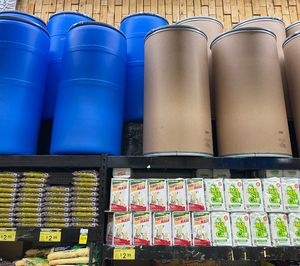Each year, millions of barrels are shipped from NYC to the Caribbean. Here's why, how, and the economics behind it.
For many Caribbean communities across New York City, carefully curating barrels to ship to relatives outside of the U.S. is a relatively common practice. Fueled by an urge to provide for loved ones left back home, the Caribbean diaspora in New York, and cities around the country, meticulously source a variety of sought-after goods, intricately packing them in barrels on the cusp of overflowing and eventually mailing them overseas. The unconventional shipping method is the most affordable way to get a hefty load abroad. More than four million barrels are shipped from the northeast to the Caribbean annually, indicating a strong demand for merchandise from the U.S and a thriving business in this niche logistic sector.
For years, I watched my partner's family in Brooklyn pack barrels to send to aunts, uncles, and cousins in Grenada. As an African American born and raised in Queens, the process was both vaguely familiar and completely foreign to me. The neighborhood I grew up in—on the border of Richmond Hill— featured many small shipping companies emblazoned with signs promising fast cargo deliveries to places like Jamaica, Haiti, Guyana, and Trinidad. But I never needed to ship anything outside of the states, so my experiences were limited to the likes of the post office, UPS and FedEx.
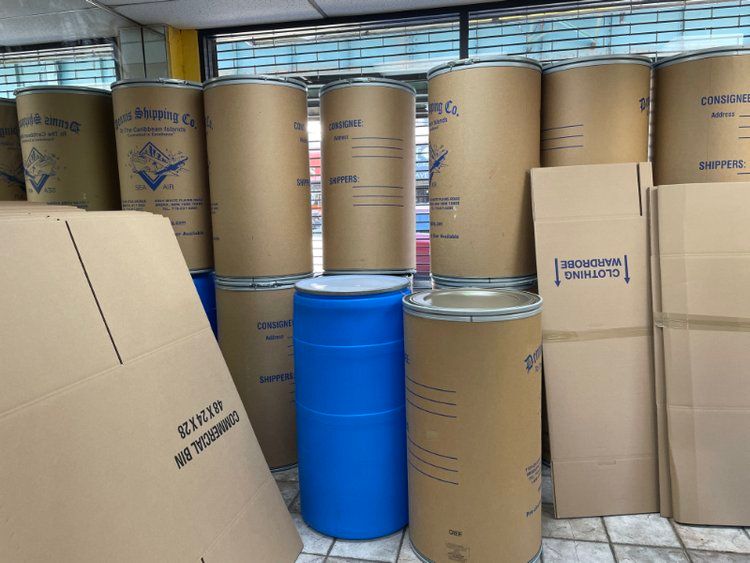
As I spent more time around my Grenadian partner and his family, my understanding of small-scale international logistics–and the crucial role that 55-gallon drums play in it–evolved. Barrels don’t just linger around collecting junk; their lifecycle is choreographed and predictable. The cardboard fiber or blue plastic containers would appear, slowly accumulate a multitude of items, and then vanish, with the process eventually repeating itself a short while later. The vast variety of goods being shipped initially confused me. While I could understand sending certain things—like name brand clothing and shoes— I couldn’t comprehend the need for basic products like bags of rice or ramen noodles. Over time, I inadvertently learned a fair amount about why Caribbeans opt to ship these things–consumer packaged goods that are totally commonplace in the U.S.– back home. Aside from a sense of obligation to look after those left behind, logistically, it just makes economic sense.
Smaller countries with less robust economies rely heavily on imported goods to supplement locally available commodities. With Grenada’s tiny population of just over 113,000, it can be difficult securing things like small appliances and electronics at budget-friendly prices. Even in Jamaica, with a population of nearly 3 million, there are many instances where it's more affordable to send common pantry goods via barrel shipments than to buy them locally. As for trendy apparel, footwear, and perfume, these items can be too expensive for some islanders to afford locally.
“I send barrels home every six months,” says Niko Bristol, who relocated from Grenada to Brooklyn two years ago. “I’ve sent laptops, juicers, generators, crockpots, clothes, groceries, and a bunch of other stuff back home.”
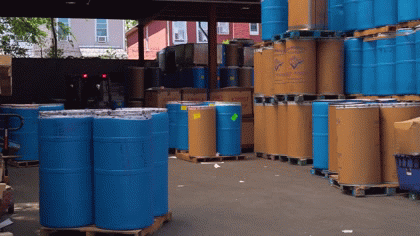
The justification for using barrels to ship goods is practical. An empty 55-gallon HDPE or HMWPE drum weighs around 10 kg, but has a capacity of around 1,200 kg. Their maneuverability also plays a large part, as they can be easily stacked, rolled, or forklifted and withstand pressure and temperature changes during storage and handling.
“The cost to ship a drum varies from one company to another but can range from $50 to $75 for a 55-gallon drum, and $75 to $100 for a 75-gallon to the Windward Islands,” says Eddie Andre, Island Operations Manager at CaribTrans in Sint Maarten. “It can cost significantly more if your cargo is traveling further.”
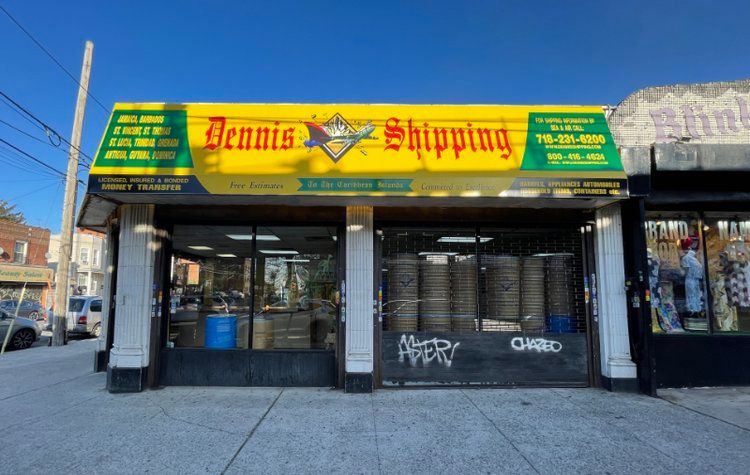
My local shipping company, Dennis Shipping in the Bronx, will deliver a 55-gallon drum to Grenada for $105. Additional services, like pre-clearance and door-to-door delivery can result in higher fees–but shipping the same drums via FedEx, UPS, or DHL could easily cost upwards of $1,000.
As for the specifics of purchasing, packing, and mailing barrels to the Caribbean, the process starts off fairly straightforward. The first step is to obtain your barrel. Take a walk through any one of New York’s Caribbean enclaves—like Brooklyn’s Crown Heights, Flatbush, and Bedford-Stuyvesant neighborhoods, for example— and you’ll likely encounter several shops, supermarkets, and local discount department stores selling barrel drums in 55- and 75-gallon sizes. Prices run the gamut, but can be as low as $30 for a single-use cardboard drum or as much as $100 for the larger blue plastic barrel. Holiday seasons can yield higher purchasing and shipping prices.
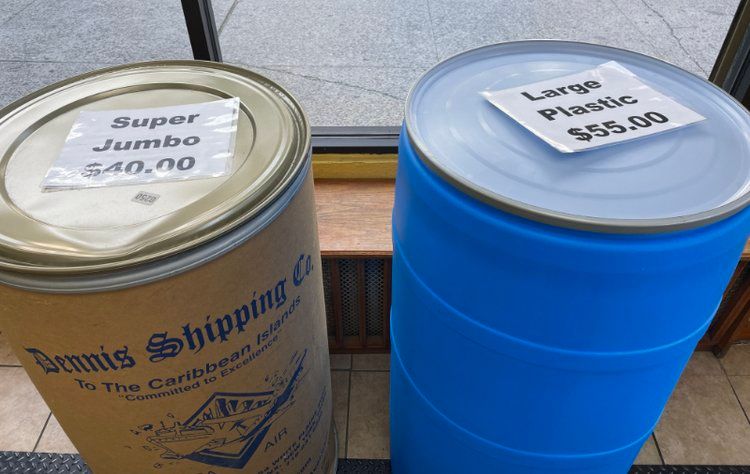
Once the barrel is obtained, you’ll need to fill it to the brim. This is one of the more intriguing aspects of the process, as it is essential that no space is left unfilled. Practices like rolling clothes as tight as possible, stuffing the insides of footwear with additional items, removing excess packaging (e.g., taking shoes out of boxes) and shoving small items like batteries and toothbrushes into nooks and crannies ensure that not even a single crevice is left void. It’s not uncommon for someone to climb into the barrel to squish the whole mass further down, provided there aren’t any breakables or spillables inside. Virtually any item can be shipped, and it can take anywhere from a couple of hours to several months to fill a drum to maximum capacity. It’s an unspoken rule that if the barrel doesn’t require a full-sized adult to sit on top of it to force it closed, there’s room to pack more! After the drum is willed shut, it is sealed with a metal clamp and locking security cable that secures the lid and ensures its contents will not be accessed while enroute. It is then labeled on the top and side with sender and receiver’s information that should match whatever is on the shipping documents.
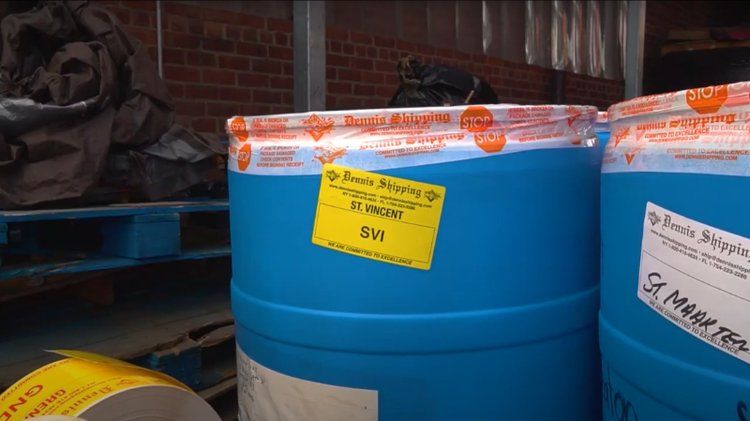
Depending on the shipping company, barrels can either be picked up from the residence or dropped off at the store’s location. Some companies allow customers to show up with loose items and have packers assist them in determining the barrel size and quantity that suits their shipment. From there, the drums are stacked inside shipping containers and trucked away, usually once or twice a week, to the next leg of the trip.
Barrels are shipped either by air or ocean freight, with the latter being by far the more popular and affordable option. While air transport results in faster delivery, it is much pricier and less practical for goods that require temperature control. If contents aren’t time-sensitive, it is likely that the barrel will travel by way of a container ship.
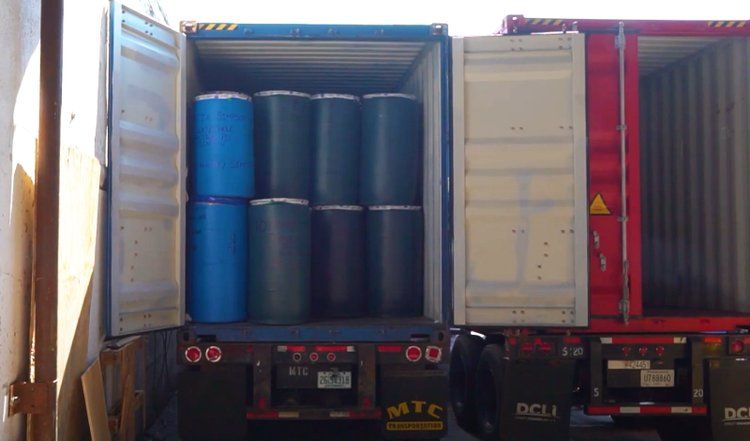
Each country has their own set of import and customs laws that govern the barrel retrieval process. In Grenada, the procedure involves paperwork and fees to clear imported goods through customs, which the recipient is responsible for if the sender didn’t pay for pre-clearance. Some companies handle this for customers and offer home delivery in the destination country, saving recipients a trip to the port.
The customs and duty fees in Caribbean countries can be highly informal. For instance, officers from the Grenada Customs & Excise Division require recipients to open barrels at the port and determine fees based on a surface-level assessment of the contents. Electronic and name brand goods result in higher fees, prompting people to attempt to conceal these items toward the bottom of the barrel when packing.
“If officers see a bunch of candy and ramen noodles in the barrel, they’ll think it’s probably just a bunch of groceries, so you want to try and put the nicer items further down to avoid paying so much to clear it,” says Vallinda Parris-Bristol, a Brooklyn resident who regularly ships barrels to Grenada. “If they find electronics, they’ll charge you for every single piece,” adds her husband, Niko.
If the country doesn’t impose import taxes, customs procedures are typically more relaxed. Sint Maarten is a de facto free-trade zone, so there are no import or export taxes and customers only pay freight and handling fees to collect barrel shipments. During a recent trip to the island, I noticed that many of the same products I buy in New York were readily available. In fact, there was almost no difference between my neighborhood ShopRite and their local supermarkets.
“That’s because we are duty free,” Andre tells me. “Technically, there is a duty, but it is currently at zero percent and has been for many years, though that might change soon if the newly proposed taxation model gets approved.”
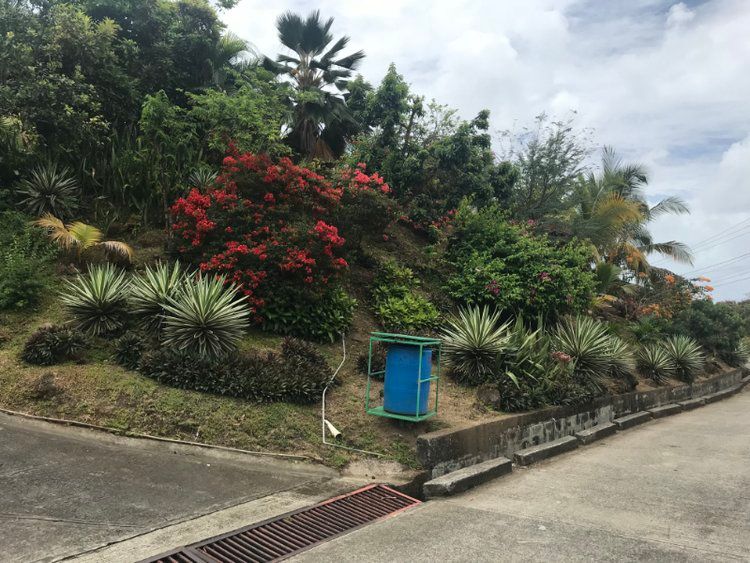
After barrels have been shipped, received, and unpacked, some go on to be repurposed. Due to their fragility, cardboard drums are usually discarded while blue plastic barrels are often retained and used for rainwater harvesting and as trash bins. It’s also common to upcycle plastic barrels as planters for vertical gardening, storage containers for dry goods or animal feed, drink coolers during a party or event, or even laundry tubs.
Despite the expansion of e-commerce, many Caribbean countries still don’t have access to simple conveniences like online shopping, making it difficult to obtain necessities. Relatives in major U.S. cities mollify this by making sure their loved ones back home get the goods they want and need, with no ocean standing in their way and no barrel packed too full.
“I’m in a position now where I can help, so I do the best that I can,” Niko proudly proclaims.


